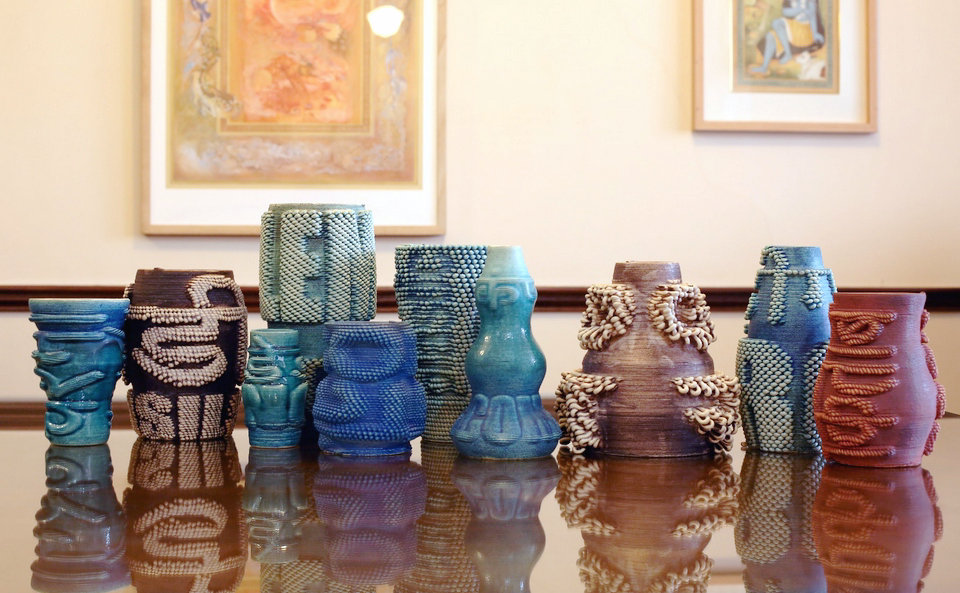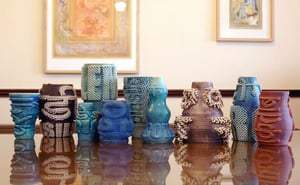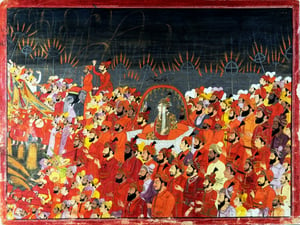The museum has decorative artefacts such as textiles, ivories, Mughal jades, silver, gold and artistic metal ware. The ivory section has artefacts dating as early as the Gupta era. It also has a collection of European paintings, Chinese and Japanese porcelain, ivory and jade artefacts. The museum also has sections dedicated to arms and armour and another to Nepali and Tibetan art. The arms and armour section contains a finely decorated armour of Akbar dating to 1581 CE, consisting of a steel breastplate and a shield, the former inscribed with religious verses.
Future Relics: Creating the archaeological artifacts of the future
A collaboration between Google Arts & Culture, Chhatrapati Shivaji Maharaj Vastu Sangrahalaya in Mumbai and the British Museum in London, “Future Relics” combined ancient craft with modern technology to ask the question: What object would you like archaeologists 1000 years from now to remember our present day culture by?
India and the World: A History in Nine Stories is a landmark exhibition that showcases some of the most important objects and works of art from the Indian subcontinent in dialogue with iconic pieces from the British Museum collection. The exhibition brings together around 200 objects not only from the collections of the British Museum, London; CSMVS, Mumbai; and National Museum, New Delhi but from around 20 museums and private collections across India. It highlights the strong connections India has shared historically with the rest of the world promoting an exchange of ideas and influences that have helped create a global culture.
What object would you like archaeologists 1000 years from now to remember our present day culture by?
“Future Relics” invited thousands of people visiting the India and the World: A History in Nine Stories exhibition at Chhatrapati Shivaji Maharaj Vastu Sangrahalaya (CSMVS) museum in Mumbai to respond to this question.
In doing so the interactive installation invited visitors to consider the importance of objects, and the stories they tell, in their own lives.
Visitors could choose to respond to the question in Hindi, Marathi or English.
These responses contributed to the design of a growing collection of vases, representing the objects that matter the most to people today.
Thousands of visitor responses were recorded in their own handwriting and imprinted onto digital versions of clay pots.
A live data visualization showed each visitor’s word grouped according to who has submitted the same word.
Each group of words formed a vase. Each new, unique word created a new vase. As vases appeared and grew a live visualisation created a growing landscape of vases; forming, fragmenting and reforming as more words are added.
Did you know?
For centuries, pots have helped us uncover the lost stories of cities and civilisations. They are some of the most prevalent findings on many archaeological sites. Distinct markings often found on ceramic vessels have helped to reveal vital insights into our past and the way we lived.
In the backend Google Translate analysed and translated the words to help group the similar words as entered in Hindi, Marathi and English, transcending language.
Visitors could choose to see the ‘connections’ they had with other visitors based on the submitted entries in the different languages.
By doing this, the interaction not only explores how objects connect, but also how stories and new meanings can be unlocked when objects are placed in dialogue with one another.
The most popular object that visitors shared was ‘Mobile Phone’.
However, there were many unique entries as well, for example ‘Tongs’.
Bringing the popular responses to life
The next question was: how to translate these responses into actual physical relics that would contain this shared memory, and could even be dug up by archaeologists a 1000 years from now?
Working with leading 3D printing studio Emerging Objects, the ten most popular responses were translated into a 3D rendering that could then be printed using clay that was handcrafted in Mumbai.
Of over 7000 responses that visitors contributed in the three month duration of the exhibition, the top 10 entries were:
1. Mobile Phone
2. Car
3. Computer
4. Can
5. Book
6. Plastic
7. Utensils
8. Gold
9. Spectacles
10. Soil
A workshop was set up at the museum premises to 3D print the vases based on these responses.
Sudents and visitors were invited see the birth of these physical relics using a very special clay that was handmade by reknowned master ceramics craftsman and a Padma Shri Awardee, Shri Bhrahmdeo Ram Pandit.
Shri Bhrahmdeo Ram Pandit is a master ceramicist. He prepares his own clay carefully in large batches and smoothens the texture out using the help of a pug-mill. The pug-mill clears out the air bubbles within the clay.
For the ‘Future Relics’ artifacts to be strong and last for years, he contributed his clay to be used in the 3D printer.
Many students lined up curiously to know more about how technology can be used to help create cultural artifacts. Virginia from Emerging Objects explains to them the step-by-step process.
Slowly and steadily all the vases grew layer by layer, each with an imprint of a word that resonated with the people today.
Here you can see the 3D printer at work, finishing up the vase with the word ‘Computer’ in both English and in Hindi imprinted.
Another top response was ‘Utensils’. Here you can see the form in English, and in Marathi – ‘Bhaandi’.
In the space of a week, 10 unique future relics were created.
Designer Ronald Rael holds up one of the freshly 3D printed ‘Future Relic’.
The final touches: firing and glazing
Shri Bhrahmdeo Ram Pandit is a master ceramicist. He not only prepares his own clay, but also his own glazes carefully and in large batches.
Before proceeding, Shri Brahmdeo Ram Pandit explained in detail the expectations from the different types of clays and glazes. With his years of experience, each step was being consulted with care.
In this photo: Shrimati Devaki Pandit, Shri Brahmdeo Ram Pandit, their son Abhay Pandit, explain to Ronald Rael the different clay and glaze treatments and their results in their large studio.
The fragile air-dried clay vases were transported from the museum to his ceramics studio miles away, to be glazed and fired by him.
Here he gets his hands dirty enthusiastically to glaze the pieces one by one.
The glaze is sprayed over the clay while on a rotating stand so that an even coat is spread and sits into all the crevices.
Ceramics need to be fired and glazed to become strong and lasting.
The air-dried clay is given a primary glaze coat and fired at 1250ºC. The second firing is done at 1150ºC with another coat of glaze.
Each artist has their own formula, and the firing is dependent on the type of clay that is used. It shouldn’t be too hot or too cool, otherwise the clay will crack.
Here, Shri BR Pandit opens the firing kiln once cool, to inspect how the vases have turned out.
Here you can see the final glazed and fired ‘Future Relics’, together a unique expression of the objects that matter most to people today.
Detail of 3D printed and glazed vase with the word ‘Mobile’
These ten ‘Future Relics’ are now housed in Chhatrapati Shivaji Maharaj Vastu Sangrahalaya (CSMVS) as a gift for future generations to uncover.
Chhatrapati Shivaji Maharaj Vastu Sangrahalaya
The Chhatrapati Shivaji Maharaj Vastu Sangrahalaya (translation: ‘king Shivaji museum’), abbreviated CSMVS and formerly named the Prince of Wales Museum of Western India, is the main museum in Mumbai, Maharashtra. It was founded in the early years of the 20th century by prominent citizens of Mumbai, with the help of the government, to commemorate the visit of Edward VIII, who was Prince of Wales at the time. It is located in the heart of South Mumbai near the Gateway of India. The museum was renamed in the 1990s or early 2000s after Shivaji, the founder of Maratha Empire.
The building is built in the Indo-Saracenic style of architecture, incorporating elements of other styles of architecture like the Mughal, Maratha and Jain. The museum building is surrounded by a garden of palm trees and formal flower beds.
The museum houses approximately 50,000 exhibits of ancient Indian history as well as objects from foreign lands, categorized primarily into three sections: Art, Archaeology and Natural History. The museum houses Indus Valley Civilization artefacts, and other relics from ancient India from the time of the Guptas, Mauryas, Chalukyas and Rashtrakuta.






